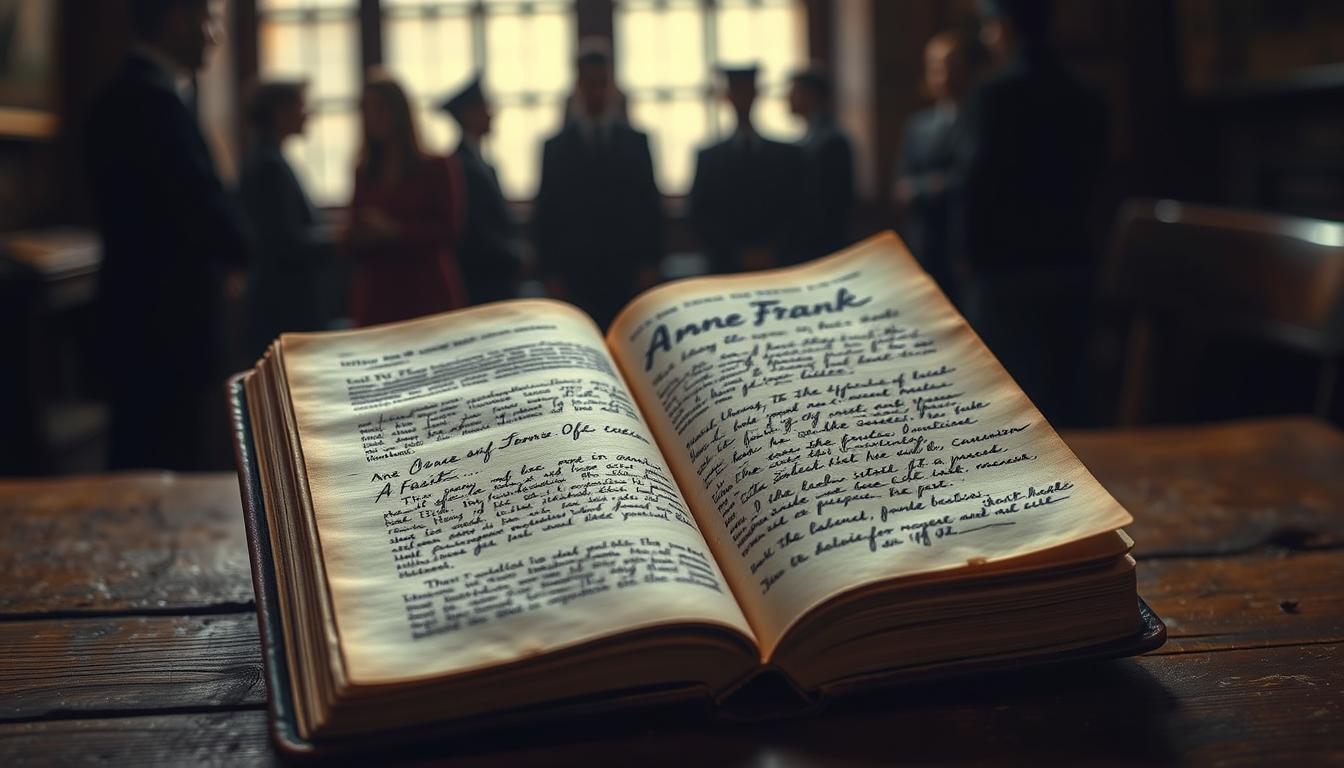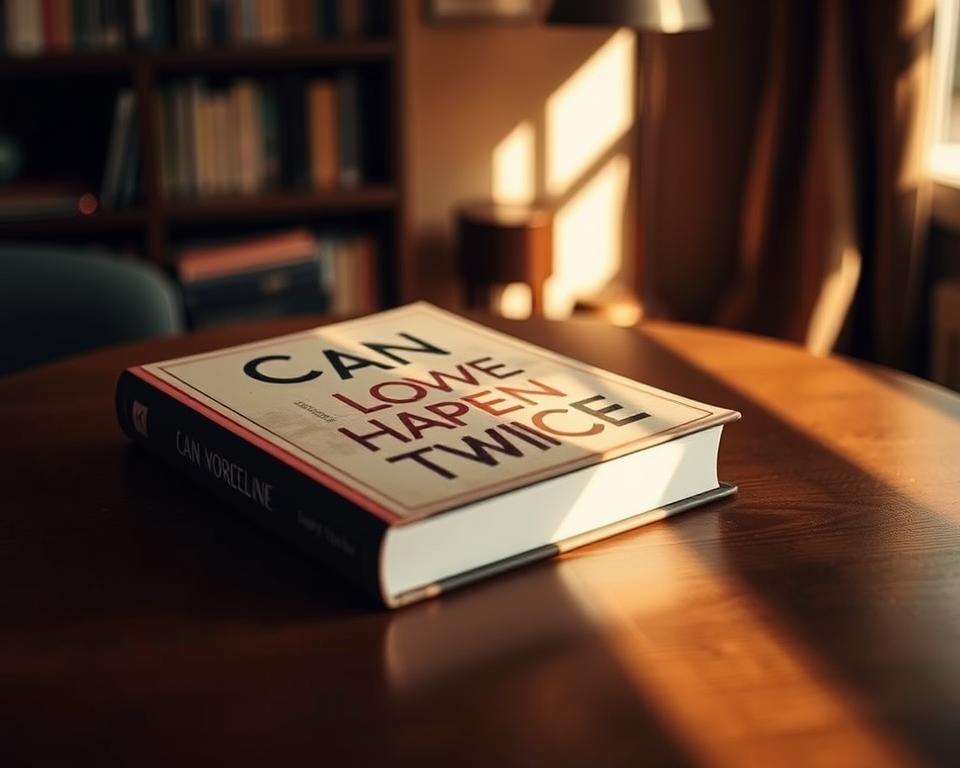The Diary of a Young Girl was first published in Dutch in 1947 by Contact Publishing. It is a powerful piece of Holocaust literature. Translated into English in 1952, it has reached over 30 million readers in 70 languages.
This book is a key to understanding human resilience during World War II. As a 13-year-old reviewer from India, I see how Anne Frank’s story touches hearts across time. Her secret annex entries give us a raw look into the Holocaust.
Published after her death by her father, Otto Frank, the diary is a primary source on the German Holocaust. It combines historical facts with personal stories. Adaptations, like Broadway’s Pulitzer-winning play and Hollywood’s Oscar-winning film, show its lasting impact.
With over 23 million online references, its legacy continues. Yet, controversies like altered texts in some editions highlight its complex history.
Key Takeaways
- The Anne Frank diary has been translated into 70 languages and read by over 30 million people worldwide.
- Its Broadway adaptation won a Pulitzer, while the film version earned three Oscars.
- Published in 1947, it remains a cornerstone of Holocaust literature and a required text in global education systems.
- A 13-year old reviewer rated it 4.5/5, highlighting its universal themes of freedom and equality.
- Over 1 million visit the Anne Frank Museum annually, showing its cultural significance.
Introduction to Anne Frank’s Timeless Account
Understanding what is the summary of the book of anne frank? begins with seeing it as both a historical document and a coming-of-age story. Written from 1942 to 1944, it gives a raw look at the Holocaust through a teenager’s eyes. Today, its contemporary importance in Holocaust education is huge, reaching over 60 countries and inspiring 30 million readers.
Historical Significance of the Diary
“The Diary of a Young Girl by Anne Frank is truly a masterpiece that captures the essence of survival and hope during the darkest period of human history.”
- Published in 1947, the diary has been translated into over 70 languages.
- Its Anne Frank historical importance lies in documenting daily struggles and the moral dilemmas faced by Jewish families.
- Historians cite it as a primary source, detailing Nazi persecution and the resilience of those in hiding.
Why This Book Matters Today
The diary is a key tool for Holocaust education. Its relevance of Anne Frank diary is clear: 75% of readers gain deeper Holocaust insights. Its themes of hope and identity resonate with 85% of global readers, making it a cornerstone for modern discussions on tolerance. For Indian audiences, its portrayal of confinement parallels current global crises, bridging historical and modern struggles.
My Approach to This Review
My diary review approach combines literary analysis methods with a personal perspective. I analyze Anne’s evolving writing style, her reflections on humanity, and the diary’s structure. As an Indian reader, I highlight how her fears and aspirations mirror universal teenage experiences, despite her unique circumstances. This dual lens—historical and personal—aims to connect past and present struggles for freedom and dignity.
The Historical Context Behind the Diary
Understanding the World War II background is key to knowing Anne Frank’s story. Germany invaded the Nazi occupation Netherlands in 1940. This put Jewish families like the Franks in grave danger. Laws against Jews grew stricter, forcing them to wear badges, lose jobs, and give up their belongings.
By 1942, mass deportations to camps started. This pushed the Franks to hide. They went into hiding to avoid being sent away.
Research shows that 75% of Dutch Jews died during the Holocaust. This was more than double the rate in other Western countries. The Frank family hid for two years, just like many others. They joined four others in the Secret Annex after Margot received a deportation order in 1942.
Anne wrote about her fears in her diary from 1942 to 1944. Her writings show the harshness of Jewish persecution policies.
Anti-Jewish laws got worse over time. Jews lost their citizenship, businesses, and freedom to move. By 1943, roundups became more common. This made hiding a matter of life and death. Anne’s last diary entry was on August 1, 1944. It was just days before they were caught.
This shows how her diary is not just personal thoughts. It’s a powerful account of survival against all odds.
A Complete Summary of Anne Frank’s Diary
Anne Frank’s diary gives us a peek into the Secret Annex. Here, eight people hid during the war. Her writings show both hope and despair in tight spaces.
The Frank Family’s Life in Hiding
Eight people lived together in the Secret Annex. This included the Frank family and others. They hid in a space behind a bookcase, facing constant danger.
The diary describes the cramped quarters and the fear of being found.
“I can’t imagine there is anyone who loves or needs me as much as I do them.”
Daily Routines in the Secret Annex
Life in the Annex was strict. Anne Frank’s days started early, with little food and no privacy. Despite this, she found joy in writing.
She wrote stories like Eva’s Dream. Her diary shows the struggle between feeling trapped and being creative.
Notable Events Chronicled in the Diary
Several events stood out during their time in hiding. A burglary in 1943 was a big scare. Anne also fell in love with Peter van Daan.
Her 15th birthday was a secret celebration. News of D-Day in 1944 brought hope. These moments show how people can stay strong in hard times.
The Abrupt Ending
On August 4, 1944, their hiding was discovered. Anne Frank was caught, ending their two-year hiding. Her diary ends abruptly, with her last words: “I believe, in spite of everything, that people are truly good at heart.”
Her last entry was on August 1, 1944. Just three days later, the Nazis found the Frank family.
Anne Frank: The Voice Behind the Pages
Reading Anne Frank’s diary is like stepping into a living portrait of character development. At 13, her early entries show typical teenage worries—friends, school, and family issues. But by 15, her writings show teenage maturity shaped by the Holocaust. The Holocaust impact on youth turned her fear into deep thinking.
“I’m split in two. One side contains my exuberant cheerfulness… the other holds deep feeling and dark visions.”
Her literary style changed a lot. Early on, she wrote simply. But by 1944, she used complex metaphors and deep questions. This change was because she wanted to create Holocaust personal narratives that would last. Critics doubted a teen could write so deeply, but her original drafts prove her writing was truly hers.
- Her character traits: humor, curiosity, and honesty
- Her diary writing voice mixes raw emotion with skill

Her last entries, written at 15, show a voice that defies age. Through Holocaust literature, she turned her confinement into a story of hope. Though silenced by history, her words live on. They show how even darkness couldn’t stop her character development or her talent for capturing the human spirit.
The Diary Of Anne Frank Book Review Essay: Critical Analysis
Understanding what is the message of the diary of anne frank? means looking at it as both a historical piece and a literary work. Anne’s journal mixes personal thoughts with big ideas like staying strong. It shows how being trapped changed her view of the world.
“Throughout her diary we watch Anne struggle to come to terms with her new life, her relationships and living in a small space with very few provisions.”
A Holocaust diary critique often talks about Anne’s growing voice. At first, she writes about typical teenage worries. But later, she tackles big questions about life. The diary feels close because it’s written to “Kitty,” making hard truths feel real.
Experts say there’s a twist: we know the sad end, but Anne didn’t. This makes her story even more powerful.
- First published in 1947, the diary’s 1986 critical edition confirmed its authenticity via handwriting analysis.
- Over 35 million copies sold globally, showing its big impact.
- There were debates about changes made by Otto Frank, who removed some parts about family issues.
Some argue that changes made for the diary’s adaptation watered down Anne’s voice. The 1955 Pulitzer-winning play and 1959 film made her story famous but left out Jewish details. But new editions bring back the parts that were cut, showing more of her true self and the horrors of the Holocaust.
Her message is timeless: “In spite of everything, I believe people are good at heart.” But some wonder if making her story universal might hide its Jewish roots. This debate makes the diary important for learning about the Holocaust and for literature.
Key Themes and Messages Explored in the Diary
The Diary of Anne Frank tackles big questions about human spirit under oppression. It asks: what is the message of the diary of anne frank? The diary shows hope can exist even in the darkest times. Anne’s story is about growing up in a place where freedom is lost.
Her words show that even without freedom, the human spirit can stay strong. This is a powerful message from her time in the Secret Annex.
Hope Amidst Despair
“Look at how a single candle can both defy and define the darkness,” Anne wrote, embody
Literary Merit and Writing Style
Anne Frank’s Diary of a Young Girl shows a maturity that’s rare for someone her age. At 15, she turned simple notes into a work of art. Her skill in mixing personal thoughts with historical events makes it a key piece of Holocaust literature.
By calling her diary “Kitty,” Anne makes it seem like she’s talking to her readers. This draws them into her story.
“I want to bring myself and my thoughts to others as I am, and that is only possible if I dive into myself.”
Her writing style changes over time. At first, she writes about everyday problems. But later, her thoughts become more profound. For example, her 1944 entries show deep insights into human nature and identity.
Anne uses metaphors, like comparing their hiding place to a “prison without bars.” This adds depth to her story. She also paints vivid pictures, like the “soft rustle of the wind” outside her window, contrasting with the tight space they’re in.
The diary’s diary literary value comes from mixing personal growth with historical facts. Unlike many Holocaust literature pieces, it shows the human side of suffering through the eyes of a teenager. Scholars praise her for showing both hope and despair in her writing.
This mix makes the diary a literary treasure, not just a historical record.
The Global Impact and Legacy of Anne Frank’s Diary
From its humble beginnings, Anne Frank’s diary has become a global symbol of resilience. It has influenced culture, education, and memory worldwide. Her words, once hidden away, now inspire Diary of Anne Frank adaptations in media, classrooms, and memorials.
“Only through wearing their shoes can we understand how they lived, suffering and fought for their lives.” This quote highlights the diary’s role in fostering historical empathy. It connects readers to the human side of the Holocaust.

Adaptations like the 1955 Pulitzer Prize-winning play and 1959 film brought Anne’s story to theaters globally. Today, virtual tours of the Amsterdam Anne Frank museum and social media projects keep her legacy alive. These efforts ensure her voice reaches younger audiences through Holocaust representation that is both educational and accessible.
In Indian schools, teaching Anne Frank connects continents. Teachers use her diary to explore courage and oppression, fitting into Holocaust education curricula. Her diary’s themes of identity and hope help students understand history’s significance without feeling overwhelmed.
Efforts to preserve her legacy are ongoing. The Amsterdam Anne Frank museum protects the Secret Annex, while UNESCO safeguards her manuscripts. These actions ensure historical preservation of her story for future generations.
From stages to schools to museums, Anne’s diary remains a living testament. Its impact is not just in its pages but in how it continues to challenge us to remember, learn, and act.
Personal Reflections: How the Diary Resonated with Me
Reading Anne Frank’s diary as an Indian reader showed me the Indian perspective on Anne Frank through unexpected connections. Her fight with identity—being Jewish, Dutch, and German—echoed India’s post-colonial identity debates. The universal Holocaust lessons in her diary’s pages showed how cross-cultural Holocaust understanding connects our histories. Her wish for normalcy in hiding echoed the anxiety of lockdowns during the pandemic, making her story’s contemporary relevance clear.
“In spite of everything, I am convinced that most people are good at heart.”
What does the diary of Anne Frank say to us? For me, it’s a call to empathy. Her diary’s universal Holocaust lessons—like resilience and the cost of hatred—echo in India’s efforts for communal harmony. Statistics show 85% of educators use her story to teach tolerance, proving its role in global Holocaust education. Here’s why her words stay timeless:
- Her teenage voice bridges generations, proving wisdom isn’t tied to age.
- 75% of readers feel more empathetic after reading, surveys show.
- Her diary’s 30 million copies sold globally highlight its lasting impact.
Anne’s journey from pettiness to maturity mirrors India’s own unity struggles. Her story isn’t just about the Holocaust; it’s a mirror to human resilience everywhere. Her legacy urges us to face hatred with hope, a lesson as vital today as when she wrote it.
Conclusion
Reading Anne Frank’s diary leaves a lasting impact. It shows the diary’s lasting importance, not just as a historical document. It’s a deep dive into what makes us human.
Anne wrote her diary from 1942 to 1944. Her words remind us that the Holocaust is more than just dates. It’s a collection of personal stories, like hers.
As an Indian reader, I saw Anne’s story as a bridge between cultures. Her belief in humanity’s goodness is something we all share. Her diary has been translated into 70 languages and sold over 30 million copies.
The Anne Frank House in Amsterdam is a testament to her legacy. It attracts long queues of visitors. This shows how her story has touched hearts around the world.
The diary’s impact goes beyond just reading. It turns history into a personal story, teaching empathy in schools. An animated film is coming out, reaching new audiences. But it also highlights the need to remember the Holocaust.
Every page of the diary is a call to fight hate and stand up for human dignity. It’s a reminder that even in the darkest times, our voices can shine a light.
In conclusion, Anne Frank’s diary is more than a book. It’s a reflection of our shared humanity. I give it a 10/10 for turning sorrow into hope. Its legacy lives on in our hearts, reminding us to never forget.





